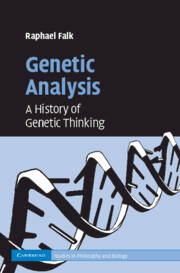Book contents
- Frontmatter
- Contents
- List of figures
- Acknowledgments
- Introduction
- PART I FROM REPRODUCTION AND GENERATION TO HEREDITY
- PART II FAKTOREN IN SEARCH OF MEANING
- PART III THE CHROMOSOME THEORY OF INHERITANCE
- PART IV GENES AS THE ATOMS OF HEREDITY
- PART V INCREASING RESOLVING POWER
- PART VI DEDUCING GENES FROM TRAITS, INDUCING TRAITS FROM GENES
- PART VII WHAT IS TRUE FOR E. COLI IS NOT TRUE FOR THE ELEPHANT
- 17 Extending hybridization to molecules
- 18 Overcoming the dogma
- 19 Dominance
- 20 Populations evolve, organisms develop
- Concluding comments
- Bibliography
- Index
17 - Extending hybridization to molecules
Published online by Cambridge University Press: 07 August 2009
- Frontmatter
- Contents
- List of figures
- Acknowledgments
- Introduction
- PART I FROM REPRODUCTION AND GENERATION TO HEREDITY
- PART II FAKTOREN IN SEARCH OF MEANING
- PART III THE CHROMOSOME THEORY OF INHERITANCE
- PART IV GENES AS THE ATOMS OF HEREDITY
- PART V INCREASING RESOLVING POWER
- PART VI DEDUCING GENES FROM TRAITS, INDUCING TRAITS FROM GENES
- PART VII WHAT IS TRUE FOR E. COLI IS NOT TRUE FOR THE ELEPHANT
- 17 Extending hybridization to molecules
- 18 Overcoming the dogma
- 19 Dominance
- 20 Populations evolve, organisms develop
- Concluding comments
- Bibliography
- Index
Summary
It is clear that the correlation between the structure of deoxyribonucleic acid (DNA) and its function as a genetic determinant could be greatly increased if a means could be found of separating and reforming the two complementary strands.
Marmur and Lane (1960, 453)When methods for in vitro hybridization of polynucleotide molecules were developed by Doty and Marmur and their colleagues (Marmur and Lane, 1960), it opened new vistas for genetic research. These new methods soon transformed and extended much of genetic research to genetic analysis of hybridization at the polynucleotide level. Such notions had been anticipated by Crick regarding the genetics and taxonomy of proteins (1958, 142): “Biologists should realize that before long we shall have a subject which might be called ‘protein taxonomy’ – the study of the amino acid sequences of the proteins of an organism and the comparison of them between species.” The beginnings of these analyses, developmental (pathological) on the one hand and taxonomic on the other, were already evident from the studies of changes of single amino acids in hemoglobin molecules (Ingram, 1957, 1963).
Hoyer, Bolton, and McCarthy isolated RNA complementary to DNA, based on the demonstration that specific cellular RNA could be hybridized with heat-denatured DNA from the same cells. The hybrids were isolated by cesium chloride density gradient centrifugation (Bolton and McCarthy, 1962). These researchers examined primarily bacterial species relationships, “where there exists only the faintest paleontological record and the simplest of all ontogenetic processes.”
- Type
- Chapter
- Information
- Genetic AnalysisA History of Genetic Thinking, pp. 249 - 258Publisher: Cambridge University PressPrint publication year: 2009



